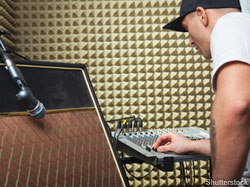We’re all familiar with the sound of rain pattering on the roof. Without thinking much about it, we expect to hear applause at a theatre performance and a sizzling sound when we place bacon in a frying pan. But are these sounds just as simple when they’re added to movie footage as sound effects?
The first thing you need to know about sound effects is that they’re not real. Sound effects aren’t produced by the action recorded on film. Usually we think of sound effects as the punches in movies that don’t actually connect or the loud gunshots that never hit their target. And sometimes sound effects added to film footage aren’t even created by the real source, but all that matters is that we believe they are.
Audio production is a vastly underappreciated art in the entertainment business because to be successful, the sound in a movie or TV episode should go unnoticed by the audience. To the average person, sound recording seems as easy as turning on the camera microphone, but in reality, the only sounds that are picked up during shooting are the actors’ voices. An audio production crew must add every footstep and sigh of the wind. Therefore, sound effects aren’t just fake noises attributed to fake actions, they include every fabricated noise that’s applied to every audible action.
How sound effects are used
Successful sound effects doesn’t mean striving for the most realistic sounds or even using realistic methods. Instead, audio production professionals apply sound effects as an interpretive art and how an audience interprets a sound determines their success. There are three major methods for applying the right sound effect:
1. Find the effect you need from an existing library of sounds, which can be manipulated using digital software.
2. Build your own reference library of sounds by recording your own effects.
3. Create your own sound effects that are tailored to the specific footage you are working with.
There are plenty of clips of sizzling bacon out there if you need them, but you can also record your own frying bacon or maybe even fake it by crinkling cellophane. So which is the best way to get the best bacon sound effect?
Some methods may work better to achieve certain types of sound. “Hard” sound effects are concrete sounds that correspond to a simple action, such as a door closing, and these usually don’t need to be customized because they’re so familiar. “Foley” sound effects, named for sound effect innovator Jack Foley, are specialized concrete sounds that are carefully designed by a sound effects technician, or “Foley artist.”
For example, a Foley artist is often needed to synchronize footsteps, which change depending on the shoe, the surface, the pace, the wearer and so on. The vaguest type of sound effects are the ongoing sounds that build atmosphere, such as mumbling voices or clicking keyboards in an office, and they are called background or ambient sound effects. Sizzling bacon can be a background noise if the camera is focused on the general action in a kitchen, but if the camera focuses directly on bacon being placed in the pan, it might need the attention of a Foley artist to sound believable.
The key to great sound effects is context. It’s possible that an audience will hear the sizzle of bacon when viewing footage of a stove, applause if the same sound is applied to footage of a stage, and rain when the sound is paired with a cloudy landscape. This flexibility allows you to be creative as long as you accurately judge what the audience expects. If you want to learn more about sound effects and gain hands-on sound effects training, consider enrolling in an audio production program.
Information in this article was provided by IADT – Nashville. Contact IADT – Nashville today if you’re interested in developing marketable knowledge and career-relevant skills with an industry-current degree program. (IADT – Nashville does not guarantee employment or salary.)

